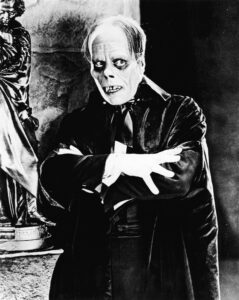Introduction
Lon Chaney’s 1925 film, The Phantom of the Opera, remains a landmark achievement in the silent film era. Released at the height of the Roaring Twenties, the film captivated audiences with its gothic atmosphere, tragic story, and the undeniable power of Chaney’s performance.

This adaptation of Gaston Leroux’s novel tells the story of Erik, a masked figure who haunts the Paris Opera House, becoming obsessed with a young soprano named Christine Daaé. Chaney’s portrayal of the Phantom, a man driven to madness by his disfigurement, is both terrifying and deeply sympathetic.
In this blog post, we’ll examine what makes this film a timeless classic. We’ll explore the innovative special effects, particularly the iconic unmasking scene, and discuss the film’s lasting impact on the horror genre. Join us as we journey back to a time when silent films reigned supreme and the Phantom’s haunting presence first graced the silver screen.
Synopsis
Deep within the grand Paris Opera House, a masked figure lurks in the shadows. Known only as the Phantom, he is a musical genius disfigured and driven to madness. He becomes fixated on Christine Daaé, a young soprano with a voice of extraordinary beauty.
The Phantom secretly tutors Christine, helping her rise to stardom. He demands her complete devotion, both to her music and to him. When Christine falls in love with Raoul, a handsome viscount, the Phantom’s jealousy consumes him. He kidnaps Christine, taking her to his subterranean lair deep beneath the opera house.
There, in his macabre domain, the Phantom reveals his true face – a horrifying sight that sends Christine reeling. Raoul, determined to rescue his beloved, bravely follows them into the Phantom’s dark world. A dramatic chase ensues, leading to a climactic confrontation and a tragic end.
Analysis
Lon Chaney’s performance is the undisputed heart of this film. He is utterly convincing as the Phantom, conveying both the character’s menace and his deep-seated pain. Chaney famously designed the Phantom’s makeup himself, creating a truly horrifying visage that remains shocking even by today’s standards. The unmasking scene, in which Christine tears away the Phantom’s mask, is a masterclass in suspense and horror. It’s a testament to Chaney’s acting prowess that he can elicit sympathy for such a monstrous character.
Beyond Chaney’s performance, the film is notable for its visual flair. The sets are lavish, recreating the grandeur of the Paris Opera House with impressive detail. The cinematography effectively utilizes light and shadow to create a sense of mystery and dread, particularly in the Phantom’s subterranean lair.
While the film is a masterpiece of the silent era, it does have some weaknesses. The acting from the supporting cast is uneven, and the plot can feel melodramatic at times. However, these minor flaws are easily overshadowed by the film’s strengths.
The Phantom of the Opera is not merely a horror film; it’s a tragic love story and a cautionary tale about obsession and the destructive power of beauty. Its themes of longing, rejection, and the duality of human nature resonate with audiences even today. The film’s influence on the horror genre is undeniable, and it continues to inspire filmmakers and artists nearly a century after its release.
Historical Context
The Phantom of the Opera arrived in theaters in 1925, a time of significant social and technological change. The Roaring Twenties were in full swing, with jazz music, flapper dresses, and a burgeoning sense of modernity. Yet, the shadow of World War I still lingered, and anxieties about societal shifts were prevalent.
In the realm of entertainment, silent films were at their peak. Technological advancements in filmmaking allowed for more elaborate sets, sophisticated lighting, and innovative special effects. The Phantom of the Opera showcased these advancements, particularly in the creation of the Phantom’s subterranean lair and the dramatic unmasking scene.
The film’s production was not without its challenges. Universal Studios reportedly spent a then-staggering $533,000 on the film, and there were disagreements about the tone and direction. Initially, the studio aimed for a more comedic approach, even adding scenes with slapstick comedian Chester Conklin. These were ultimately scrapped, and the final version leaned heavily into the darker, more dramatic aspects of the story.
Interestingly, the film’s release coincided with the rise of “phantom” scares across the United States. Reports of mysterious figures and strange occurrences in theaters capitalized on the film’s popularity, further fueling public fascination with the macabre. In this context, The Phantom of the Opera tapped into both the excitement and anxieties of the era, offering audiences a thrilling escape into a world of mystery and horror.
If you’re a fan of classic cinema or simply curious about the origins of the horror genre, The Phantom of the Opera is a must-see. Dim the lights, settle in, and prepare to be transported to the shadowy depths of the Paris Opera House, where a masked figure awaits.
